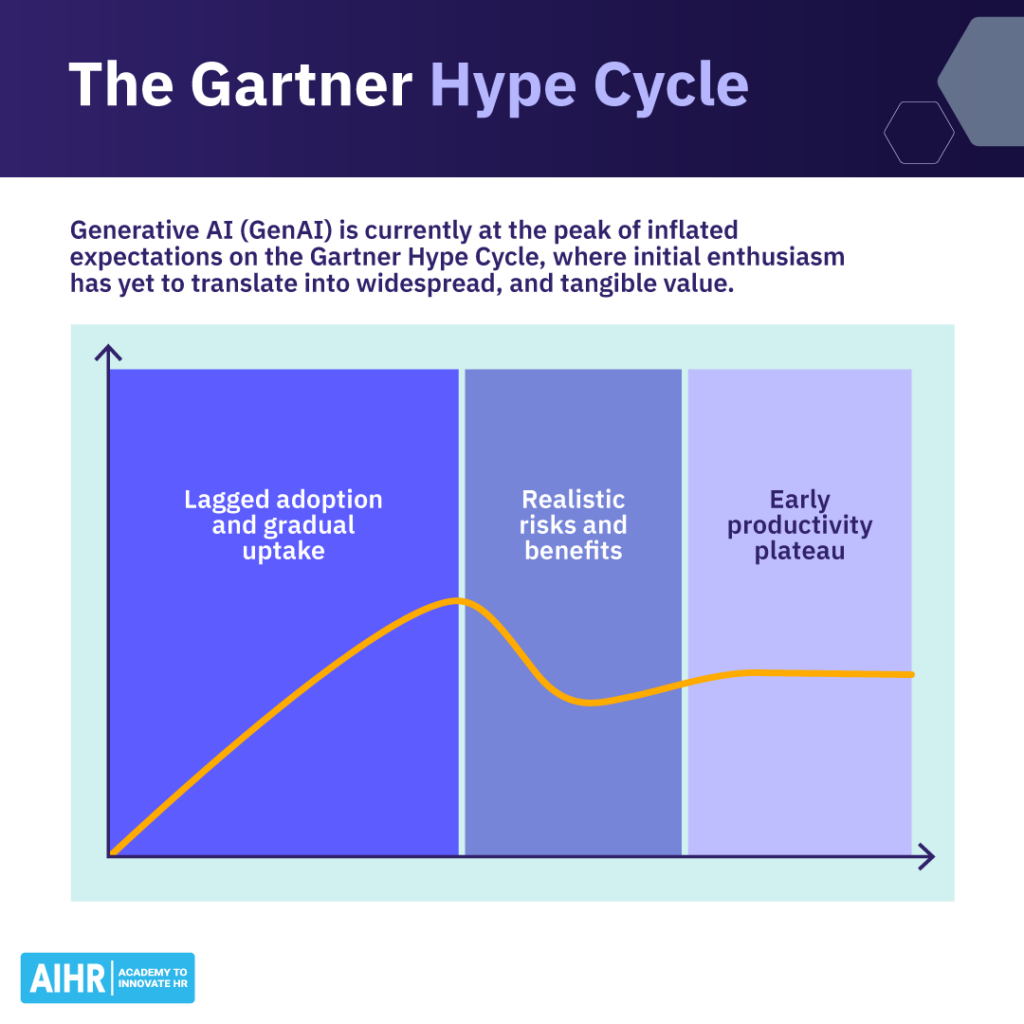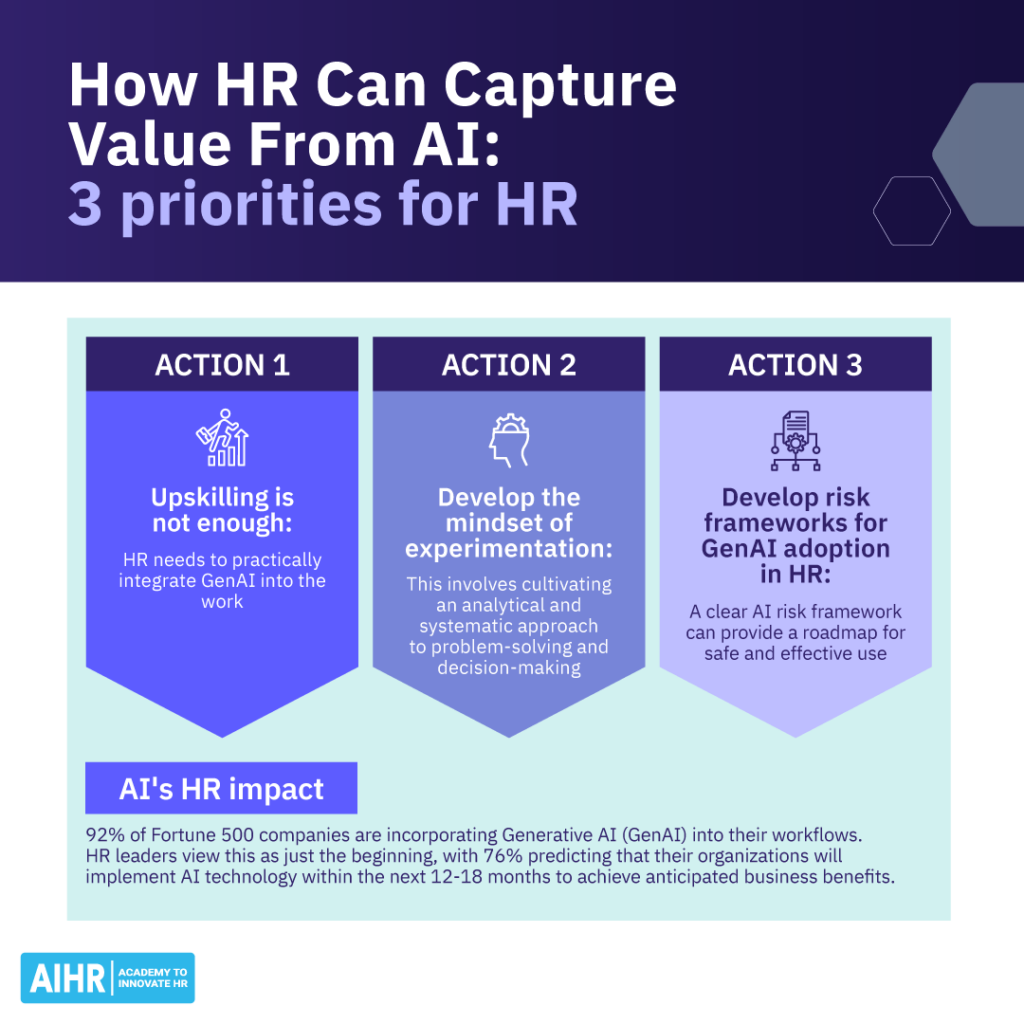In brief
- We examine the current state of using AI and GenAI in HR, the challenges faced, and strategies for responsible implementation, based on research involving over 1,137 HR professionals.
- Despite initial enthusiasm for GenAI in HR, widespread adoption and tangible value remain elusive due to regulatory, ethical challenges, and a cautious approach from HR professionals.
- HR professionals face obstacles in adopting AI because of a lack of digital competence, confidence, and clarity, resulting in cautious behavior and difficulty integrating the technology into existing processes.
- To successfully use AI in HR, it’s essential to focus on integrating upskilling, fostering an experimentation mindset, and developing clear risk frameworks to enhance digital competence, confidence, and responsible AI usage.
While AI has been available for some time, the launch of the Generative AI (GenAI) tool ChatGPT and subsequent rival applications garnered much interest. Since then, there has been a dramatic increase in the adoption of GenAI tools, including Microsoft’s Copilot and Google’s Gemini.
In fact, 92% of Fortune 500 companies are incorporating Generative AI (GenAI) into their workflows.
In the Human Resources field, HR leaders believe this is just the beginning of AI adoption. 76% predict that their organizations will implement AI technology within the next 12–18 months to achieve anticipated business benefits or face the risk of lagging behind.
Many HR departments have been eager to experiment with GenAI. Use cases range from managing employee records to recruitment, onboarding, and analytics. Broader AI adoption use cases include (but are not limited to) AI-powered talent acquisition tools, AI-supported learning development, and performance management.
Despite the opportunities AI offers HR widespread, sustained adoption has yet to happen, with concerns raised about privacy, data security, and internal governance barriers. Without addressing these issues, the potential productivity gains promised by AI in HR may remain unfulfilled.
In this article, we draw on research conducted by AIHR involving over 1,137 HR professionals across various companies. We explore the current state of AI and GenAI adoption in HR, the challenges hindering its broader use, and strategies for responsibly harnessing its value.
Has the hope lived up to the hype of emergent AI in HR?
Gartner’s Hype Cycle succinctly illustrates the rise and fall of emerging technologies like emergent AI. GenAI is one example of an emergent AI.
The graphic shows specific technologies’ maturity, adoption, and social application. It consists of five phases:
- Innovation trigger: A breakthrough or innovation generates significant interest and media coverage.
- Peak of inflated expectations: Enthusiasm and unrealistic expectations build up as early successes and failures are reported.
- Trough of disillusionment: Interest wanes as experiments and implementations fail to deliver. Some producers fail or exit the market.
- Slope of enlightenment: Understanding and practical application of the technology as its use grows, with more realistic and informed perspectives.
- Plateau of productivity: The technology becomes mainstream, demonstrating real-world benefits and stable adoption.
Currently, GenAI is at the peak of inflated expectations on the Gartner Hype Cycle, where initial enthusiasm has yet to translate into widespread, sustained adoption and tangible value. In addition to ongoing regulatory and ethical debates, many organizations face challenges in identifying practical use cases that fulfill GenAI’s broader promise beyond simply enhancing individual productivity within their teams.

Our sentiment analysis of 1,173 HR professionals reveals a cautious and skeptical outlook for GenAI’s long-term value in HR. While participants indicate a desire to experiment with GenAI, they struggle to envision its practical integration into HR solutions at scale. The sentiment shows that HR has been wary of the hype and prefers to take a more measured and risk-averse approach.
This aligns with our compliance and risk management roots within HR. Although this has successfully insulated the HR function against specific risks, it also results in GenAI adoption and HR lagging behind the business. This trend is not new and mirrors previous adoptions, such as the slower introduction of SaaS technologies in HR.
Most HR GenAI adoption at the moment is largely vendor-led, with recruitment technologies dominating this space. This situation raises crucial questions about how HR can unlock GenAI’s potential, address barriers to adoption, and expedite the transition through the “trough of disillusionment” to fully realize its benefits.
3 obstacles blocking HR’s adoption of AI
We found three obstacles that HR professionals face that inhibit the adoption and use of AI within HR. These include competence, confidence, and clarity around how and when AI should be used.
1. HR’s digital competence lags
Digital Agility is the lowest-rated competency for HR professionals, based on data from over 2000 HR professionals who have completed our T-Shaped HR Competency Assessment. Only 9% indicate they have the right skills and are fully equipped to use and apply digital technologies. With accelerated technology development, such as AI, this lack of digital competence continues to lag.
Most HR professionals are optimistic about AI’s potential and how it can enhance their personal effectiveness and HR practices. However, specifics like prompt engineering, using GenAI in collaboration with other technologies, and image creation are critical areas of concern for HR professionals. In addition, being able to evaluate and apply AI outputs is also a notable skill gap.
HR professionals also report struggling to integrate GenAI into existing HR processes practically. They cite a lack of the ability to spot opportunities to use GenAI and the technical skills to incorporate the technologies as key obstacles.
- HR professionals lack digital agility as a core competency
- Engaging with GenAI technologies through prompt engineering and integration with other technologies remains a missing skill
- Without the necessary skills, HR professionals cannot effectively use and incorporate GenAI into their work
2. HR professionals don’t feel confident about using AI
In addition to a lack of skills needed for AI use, HR professionals also don’t have confidence in their ability to experiment with AI. Although HR has started to experiment with AI, it’s still predominantly used for personal productivity and efficiency. For example, AI is used to draft emails, create communications, and research topics.
HR individuals also indicate that, in terms of digital technologies, they often feel that they lack an experimentation mindset to become confident in their use. HR professionals come from a background of risk, quality, and zero tolerance for mistakes, leading to cautious behavior when it comes to new digital innovations.
- Limited confidence of HR professionals in experimenting with GenAI
- HR professionals struggle to see the application of GenAI at scale beyond personal productivity.
- Investing in HR technologies without the confidence to use them leads to wasted investments and resources
- Scaling AI beyond personal productivity can foster innovation and enable new ways of working for HR professionals.
3. A lack of clarity leads to cautious behavior
How HR professionals engage with AI in their day-to-day work is hallmarked by caution and risk avoidance. There are many concerns around responsible adoption, data security, and privacy. This is further pronounced in inherently high-risk applications such as hiring decisions or related to sensitive topics like diversity, equity, inclusion, and belonging or advice on legal matters.
Because of a lack of clarity on when to use GenAI, many HR professionals prefer not to engage with the technology at all, choosing to err on the side of caution.
- The history of risk avoidance and caution is limiting HR in their exploration of GenAI
- HR is not willing to take risks for fear of inappropriate use
- A lack of AI experimentation due to cautiousness hampers the development and application of new skills
Taking action: 3 priorities for HR to capture value from Gen AI
Considering the current reality of AI adoption within HR, simply introducing more AI tools into HR is not the solution to driving sustainable adoption. Instead, we must address the issues of digital competence and the lack of confidence in using AI and clarify how AI should be used responsibly.

Action 1: Upskilling is not enough — integration is needed
Upskilling and reskilling HR to develop digital competence in using AI involves a structured approach that combines education, practical experience, and continuous learning.
Start by evaluating the current digital competence of the HR team to identify exact gaps in knowledge and skills. Align this to your AI strategy and use it within HR. For example, recruitment practices, automation of processes, or using AI tools to improve personal efficiency. Provide formal upskilling opportunities on relevant AI concepts, tools, and specific platforms.
Experimentation and incremental adoption help clarify how AI can be used and, over time, create momentum for adoption across various processes and practices. They provide clear guidelines for HR professionals concerned with associated risks, mitigating risk-averse behaviors that often inhibit use. Supporting adoption through upskilling and use case examples builds confidence in using AI beyond personal efficiency and automation.
Create low-stakes opportunities for HR professionals to experiment with new AI technologies. This is critical to upskilling and builds confidence in individual competence and AI capabilities.
In the longer term, it ensures that AI technologies can unlock their full productivity potential and are maximized to show a return on investment.
Action 2: Develop an experimentation mindset
Developing a mindset of experimentation begins with understanding and embracing different thinking styles. This involves cultivating an analytical and systematic approach to problem-solving and decision-making. HR professionals can better navigate the digital landscape by learning to break down complex issues into manageable parts and critically examine them. This analytical mindset reduces the perceived risk of experimentation by providing a structured framework for understanding potential outcomes.
Additionally, fostering a sense of curiosity and openness to learning is crucial. These attitudes encourage the exploration of new technologies and methods without fear of failure. This involves adopting habits and behaviors that promote continuous learning and adaptability. For example, maintaining a curiosity about the latest digital tools and trends allows individuals to stay updated and informed, which can boost their confidence in trying new approaches.
Enhancing digital awareness is another key component of developing an experimental mindset. Additionally, by regularly engaging in low-stakes digital tasks, such as experimenting with new software features or participating in online forums, individuals can build skills and experiences. This practical exposure helps demystify the digital world and reinforces the belief that failure in a controlled, low-risk environment is simply a stepping stone to mastery.
Practical knowledge and hands-on experience with digital tools can significantly boost an individual’s confidence in their ability to navigate and use digital resources effectively. This confidence is crucial when experimenting with new techniques or tools.
Action 3: Develop risk frameworks for GenAI adoption
While many HR professionals may be concerned about using AI technologies, a clear AI risk framework can provide a roadmap for their safe and effective use. This framework helps to manage any risks that may arise and also serves to dispel any myths and misconceptions that could hinder the adoption of AI. By outlining risks associated with both content generation and use and the intent of application and use, this framework paves the way for a more confident and informed use of AI in the HR field.
We have previously discussed an AI Risk framework specifically related to recruitment, yet more work is required to make these frameworks easy to access, validate in practice, and adopt as a way of working within HR.
Final words
AI is radically transforming every aspect of work, and HR has never had more opportunities to leverage this transformation. However, HR needs to develop more skills to become more confident and competent, which might be limited by our current beliefs and inaction.
To overcome these limitations, we need to take bold and brave action. Equally important is creating environments that encourage responsible experimentation and foster the development of digital mindsets and skills.








